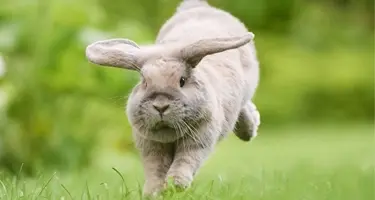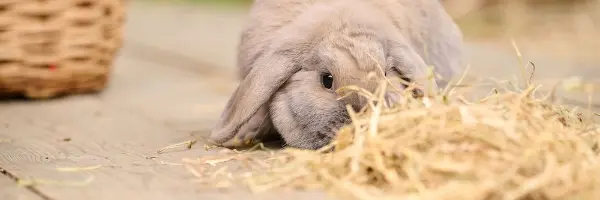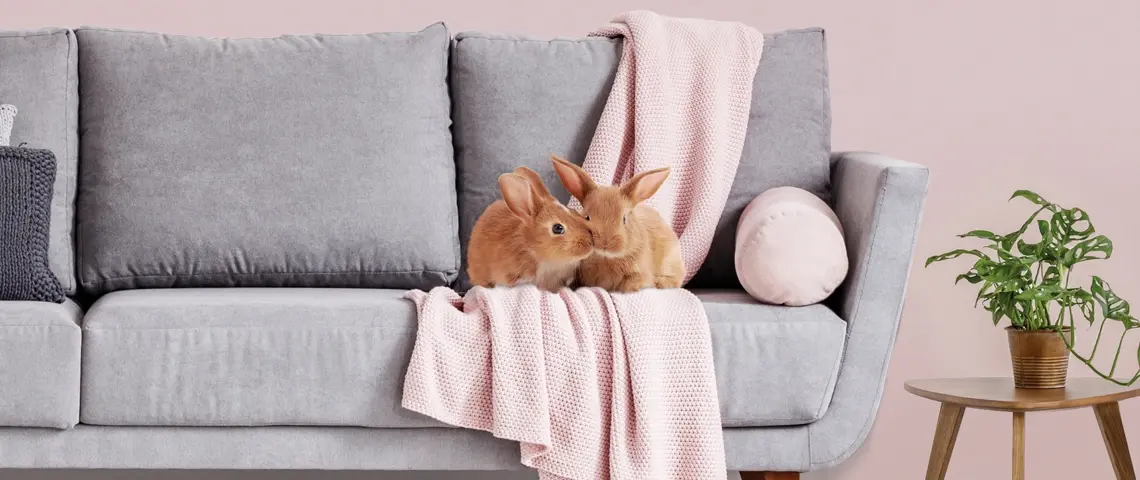Make rabbits friends for life with this step-by-step plan!
As a rabbit lover, you probably know better than anyone that you cannot keep a rabbit on its own. A rabbit is really a group animal, so it likes to live together with a buddy. To pair rabbits you need a thorough approach and knowledge of rabbit behavior. It is also wise to look at the sex and character of the two rabbits. You have to be well prepared for it, because you want them to become friends for life. There are several ways to make rabbits friends. We have the tips and a step-by-step plan for you to properly guide the coupling of rabbits.
Step 1: Observation of behaviour
Introducing two rabbits is not something you just do. It is important that you recognize small signals of rabbit behavior. Never leave the rabbits alone when introducing and make sure you observe closely what is happening. For example, do you know what it means when rabbits exhibit behavior such as:
• Wash/clean themselves
• Wash/clean each other
• Keep their ears straight forwards or backwards
• Ride on each other
• Circle around each other
• Put up their tail
• Sit and turn their backs on each other
The problem is that the same behavior can also have a different underlying reason. For example, a behavior that may appear a bit negative at first sight (ignoring, chasing each other, etc.) does not always have to be. For example, your rabbit can bathe when he feels comfortable, but it can also be jumping behavior if he finds it an uncomfortable situation. The ear game can also mean something else. Ears forward: curiosity or start of aggression. So there are many other (small) signals that you can see when pairing, and to avoid confrontations it is important that you are aware. These signals give you a lot of information. Whether it's going in the right direction or not. That's why you should familiarize yourself with rabbit behavior before you get started with coupling rabbits. Do you find it difficult? There are several rabbit behavioral experts who can help you.
Step 2: Getting used to each other from a distance
Before you physically place the rabbits together, it is wise to let them get used to each other from a distance. Rabbits can be very territorial. If they have already been able to get used to each other's scent, this often facilitates the process of the actual pairing. What can you do for this:
- Move the residences closer together within a certain time span. They can see and smell each other, but are not able to physically touch each other. This is already a way of introduction.
- Another possibility is to switch the rabbits from their cages several times. The space has the smell of the previous occupant. That resident is the new friend they will soon meet. Scents are very important for rabbits and by getting used to the other scent, a first step has been taken in getting to know them.
A combination of both options works quite good most of the time.
Stap 3: Choose location for introduction
The location of the introduction is a very important part to consider. It really helps in the success of the pairing. Keep the following in mind:
- Neutral territory
It is best to mate rabbits in neutral territory. If you want to introduce rabbits in an environment where one of the rabbits is already housed, this can make pairing more difficult. Rabbits are territorial and will want to defend their own territory. With a neutral location, think of, for example, the bathroom, the hallway or another place where both rabbits have not been before.
- Location size
If you use a very large space for mating, the rabbits can completely avoid each other or ignore each other. Of course, if the location is too small, they cannot give each other space. You can assume that a space of 2 x 3 m is a good size for linking rabbits.
- Place to hide
During mating, a rabbit sometimes likes to withdraw and be out of sight of the other rabbit. You can do this, for example, by placing a cardboard box in the room. This way a rabbit can sit behind it and recover for a while. Do not make a hole in the box so that they can sit in the box, because if the rabbits both sit in the box, the space is too small. It is also difficult for you to intervene if something goes wrong.
- Cleaning
Has the time come for both rabbits to go into the final enclosure together? Then make sure you clean the loft well and neutralize the urine odor. For example, you can do this with Beaphar Probiotic Spray Away. Of course, also replace the entire floor covering. Take the objects used on the neutral terrain with you to the final residence (eg toilet, toys, hay rack). This ensures recognizability in terms of smell and the prevention of conflict.
Stap 4: Rabbits together in their home for the first time
An exciting moment! Your rabbits will now really get to know each other at the carefully selected location. Stress negatively affects the pairing, so you want to avoid that as much as possible. Did you know that there are also support resources that can help with rabbit mating? Beaphar RabbitComfort® supports rabbits in stressful situations with a copy of the body's own pheromones. You can read how pheromones work on this special page: RabbitComfort®.
The final preparations
Before you place the rabbits together, also prepare some important materials. You want to intervene when things go wrong and not hurt yourself. So gloves or a towel are good to have within reach. Before pairing, put a towel within reach or put on gloves. If things go wrong, do not immediately separate rabbits. Clap your hands can be enough to distract the rabbits and restore peace for a while.
The first introduction
You can do the first acquaintance in different ways. You can choose to put the rabbits together and keep this as long as it goes well. Of course you observe the behavior carefully and you do not just leave them alone. If there is a conflict, separate the rabbits and try again later. If you start mating in the morning and the rabbits on neutral territory have not had any conflict, you can decide at the end of the day to put them together in the final enclosure. Please note everything depends on the behavior of your rabbits and whether you can take this step that day, you never know in advance. Stress, including displacement, can also influence behavior. Good observation and knowledge of rabbit behavior is essential when pairing rabbits.
Another method is to do the pairing process in short sessions. Keep the first pairing session short. How short, of course, depends on the behavior of both rabbits, but usually 10 minutes is sufficient. You repeat this 3 to 5 times a day. If all goes well, you can extend the duration. You often see a lot of progress and friendly behavior towards each other after 1 week. Usually the rabbits can really get together full-time after 2 weeks at the latest.
Which method you choose depends on your experiences, knowledge and of course your own preference which you suspect best suits your rabbits. Are you in doubt? Then ask someone who has a lot of experience in pairing rabbits for help.
Determine ranking
An important part for the rabbits is determining the ranking among themselves. They do this by washing and riding each other. Rabbits do ride regardless of gender and really has to do with some form of dominance. Often the rabbits ride each other to scan and determine the ranking.
Prevent fighting
You want to avoid a real fight. As mentioned before, there are a lot of signals that you can observe before a fight. If you recognize the signals, you can prevent a real fight by distracting the rabbits at that moment. This way you avoid the real confrontation and you promote successful pairing.
Succesful introduction
If both rabbits seem comfortable, eating well, walking around the enclosure quietly, then it looks good. If they dare to sit with their backs to the other rabbit, they no longer see it as a threat. They will start to see each other more and more often and get closer to each other. If they lie together or wash each other, the ranking is established.
Of course, the relationship is still a bit vulnerable in the beginning and can still be influenced if they are shocked or stressed. Therefore ensure peace in the area with Beaphar RabbitComfort®, it offers your rabbits continuous support.
One last tip for the introduction of new rabbits
Does it all seem a bit complicated to you or are you not sure? A rabbit behaviorist can give you good advice or help you pair your rabbits. Even if things go wrong, you can of course ask them for help, but also with successful pairing the following applies: Prevention is better than cure. So when in doubt, always seek help from an expert.
Discover the RabbitComfort® range:
Also interesting

Potty training a rabbit, the tips for good results

Myiasis (maggot disease) in rabbits




